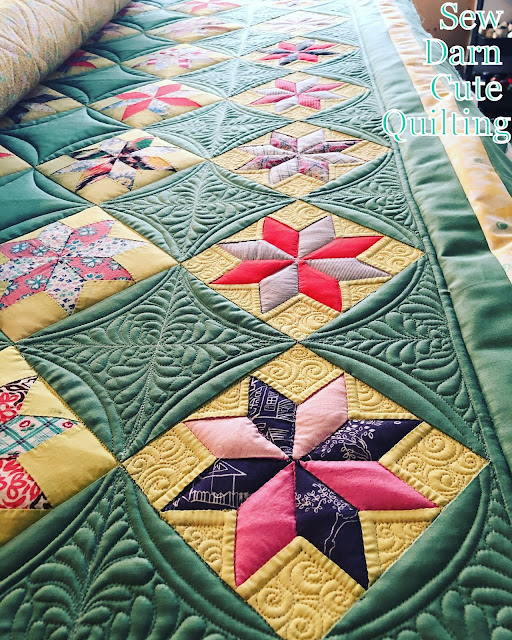Eagle Quilt
Thanksgiving has just ended and here I sit cider close by ready to get this next post out to you. It has been sitting in my "Unposted" box for a while. With 2 custom quilts on the board all of my other quilts fell behind. So it was a mad dash to get them completed and back to their homes. I am down to 2 quilts then I plan on working on some renovations and my own quilting with some teaching videos to come. The list is long for both.
Take a look at this amazing Eagle quilt below. This quilt was exciting and intimidating all in one.
This one is definitely a Custom Job.
This custom quilt is no different from any other custom quilt. Which means the designing process took some time. Below it is hanging up ready and waiting to be put on the frame quilted.
The applique on this quilt was perfect.
Check out the stitches from the back on the picture below.
Time to get started.
Once the quilt is loaded and all flat. I feel that basting the quilt helps to keep tucks to a minimum on the back.
Also, this is very helpful when you turn your quilt.
All of the layers stay right where they are supposed to be.
All of the layers stay right where they are supposed to be.
Many different threads and colors were used.
This feather is what finally broke through the designing process for me.
Four of these feathers were quilted just outside of the center point.
Four of these feathers were quilted just outside of the center point.
Once all 4 of them were quilted the rest fell into place.
Then the center circle(above) and the four outer corners were filled with dense swirls.(below)
Each corner has this dome of swirls.
Then the crosshatching was afoot. :) So much crosshatching
The tools I used: (below)
-an 18" ruler to match up the lines from each side of the quilt.
-a purple disappearing marker (which worked great)
Working outward from the center. Making sure that the crosshatching matched up.
More like praying.
Loose open swirls were quilted under the wings around the whole quilt.
The red wings had double bump feathers.

The brown parts of the eagle have pointy feathers.
Borders
Straight lines all around in the blue and red I also changed the thread colors.
It's very rare to densely quilt a quilt and not have wavy borders. When you are densely quilting the center of your quilt it will scrunch up. Once you get to the border you will have the same scrunchiness happening. This causes wavy borders. So do many other things but this is the case for this quilt and many others I have quilted dense quilting is the culprit.
How I tackled wavy borders on this quilt?
First I quilted the stem for the feather which will help secure the border.

Then(below) I used a wavy line of stitching along the outer edge of the border to grab it just a bit here and there. If you go with a straight line will cause a big pucker at the end of the border.
The purpose of this wavy line is to help hold down the edges of you border while you quilt your motif. This method will help to keep tucks from happening in the middle of your motif.
My motifs are feathers with stipples on the outer edges.
Using a dense motif such as stippling or piano keys(straight lines) will help ease in any bulk you may have in your quilt.

Before I remove the quilt from the frame I like to take a good look at all of the stitching to make sure that I have not missed any stitching. This is a must and sometimes I will go over it many times before removing the quilt.
With all of the crosshatching it is very easy to miss a line or 2. So I like to stick a pin in the spots that need quilting and before I roll the quilt again, I will make sure to quilt the pinned spot.
This quilt was a ton of fun to quilt and learn new quilting skills.
I find with each quilt I learn something new.

Learning is Growing and without growth we become stagnate.
So keep Learning and Growing.
Without Change we will never Grow. So step out of you comfort zone and do something new.
This quilt was way outside of my comfort zone and it helped me to become a better quilter.
Thank You,
Sandra
for sending your quilt to me and being so patient.
My little Angel



































Spectacular! The post, the quilting, the tips throughout!
ReplyDeleteThank you, Ka Holly You are so nice to comment on my post. I am so grateful for you.
DeleteBeautiful design work! What type of thread do you use for the basting? Do you do any vertical basting or is it only horizontal? Is it removed after all the stitching? Your posts are so helpful!
ReplyDeleteJanie
Janie, Great questions. For the Thread I use what is on my machine at the time. But, as I think about it a fine shinny thread might come out better. I only use Horizontal lines but you could use a gigantic stipple design. This will really hold your quilt together. Removing the stitches is best done right before you quilt the area. You could wait and take them out after quilting but then you might pull out the wrong stitches. If you do wait just be careful and use a ton of lighting with a light tug and pull. Tweezers are helpful. I know it may seem like a lot of work to baste and remove but for me it is more work to unsew. Which takes forever and comes with a bunch of frustration. If you try it once you won't go back. :)
Delete